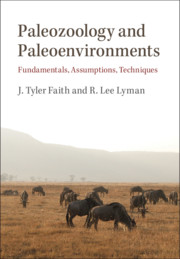Book contents
- Paleozoology and Paleoenvironments
- Paleozoology and Paleoenvironments
- Copyright page
- Contents
- Figures
- Tables
- Acknowledgments
- One Why a Book on Paleoenvironmental Reconstruction from Faunal Remains?
- Two Fundamentals of Ecology and Biogeography
- Three Analytical Assumptions
- Four Background of Select Paleozoological Samples
- Five Environmental Reconstructions Based on the Presence/Absence of Taxa
- Six Environmental Reconstruction Based on Taxonomic Abundances
- Seven Taxon-Free Techniques
- Eight Environmental Inferences Based on Taxonomic Diversity
- Nine Transfer Functions and Quantitative Paleoenvironmental Reconstruction
- Ten Size Clines as Paleoenvironmental Indicators
- Eleven Some Final Thoughts
- Glossary
- References
- Index
- References
References
Published online by Cambridge University Press: 11 February 2019
- Paleozoology and Paleoenvironments
- Paleozoology and Paleoenvironments
- Copyright page
- Contents
- Figures
- Tables
- Acknowledgments
- One Why a Book on Paleoenvironmental Reconstruction from Faunal Remains?
- Two Fundamentals of Ecology and Biogeography
- Three Analytical Assumptions
- Four Background of Select Paleozoological Samples
- Five Environmental Reconstructions Based on the Presence/Absence of Taxa
- Six Environmental Reconstruction Based on Taxonomic Abundances
- Seven Taxon-Free Techniques
- Eight Environmental Inferences Based on Taxonomic Diversity
- Nine Transfer Functions and Quantitative Paleoenvironmental Reconstruction
- Ten Size Clines as Paleoenvironmental Indicators
- Eleven Some Final Thoughts
- Glossary
- References
- Index
- References
- Type
- Chapter
- Information
- Paleozoology and PaleoenvironmentsFundamentals, Assumptions, Techniques, pp. 319 - 394Publisher: Cambridge University PressPrint publication year: 2019



